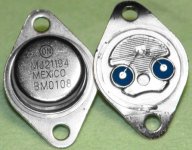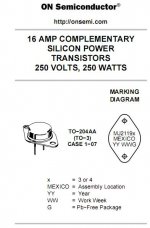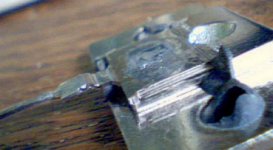I'm pretty sure these are fakes based on the size of the die. It's pretty telling.
Compare to the photo of real ones on Rod Elliot's website.
The description on eBay said they were manufacturing surplus, and as someone who works for manufacturer, I know we unload our surplus supplies for 10% value when we change our products. So the story is always plausible. I think not this time though.
Real ones:
http://sound.westhost.com/fake/fakes-r1.jpg
Mine:
Compare to the photo of real ones on Rod Elliot's website.
The description on eBay said they were manufacturing surplus, and as someone who works for manufacturer, I know we unload our surplus supplies for 10% value when we change our products. So the story is always plausible. I think not this time though.
Real ones:
http://sound.westhost.com/fake/fakes-r1.jpg
Mine:
Attachments
I hope you left some major negative feedback on the dude.
A lot of sellers won't leave buyer feedback until after the buyer rates the seller. This allows them to withhold their rating until they're sure you gotten screwed and learned to smile about it. It allows them to blackmail the buyer into giving good feedback even when it is undeserved. This is just one of e-bay's bad policies, but then they only care about sales commission.
Caveat emptor! Buyer beware!!!
I've had sellers retaliate by leaving negative feedback against me for rating them poorly, which is the rating they themselves EARNED, but even so, it's worth it to get the message out so other buyers don't get screwed unwittingly. Their retaliation has very little impact against a buyer anyway. Who cares if the buyer is a flake as long as the check clears?
Nowadays, nobody seems to care about anyone but themselves. Of course our group here seems to be an exception to that rule, which is why I love this forum so much.
Another bad e-bay policy is allowing both parties to mutually withdraw their feedback. This goes along with what I posted above, giving sellers an unfair advantage. When I see mutually withdrawn feedback, I know both parties are more concerned about other's opinions, than of their own. It means someone compromised their integrity, and that kind of compromising is a character flaw in my book. If feedback isn't about integrity and character, then what purpose does it serve? If feedback is swapped back and forth for gain, it becomes nothing more than bought and paid for advertising. And we all know that advertising rarely represents the whole truth.
And even if feedback ends up being nothing more than advertising, then I would make sure to advertise the guy's negative character traits in his feedback. But if he indeed earned it, I would never withdraw it.
Off Topic rant/
I swear this whole world revolves around advertising. If they're not cramming it down your throat on TV every four minutes, it's the radio, your telephone, your mailbox, your inmail, it's on your doorstep, it's under your wiper blades, it's on your bought and paid for DVD's, and it's even on your milk cartons.
I mean holyschitt ... think about it... I could become richer than Bill Gates if I could re-engineer a moth's DNA to be hatched carrying it's own banner add. "Tan don't burn... use coppertone!"
/soapbox
A lot of sellers won't leave buyer feedback until after the buyer rates the seller. This allows them to withhold their rating until they're sure you gotten screwed and learned to smile about it. It allows them to blackmail the buyer into giving good feedback even when it is undeserved. This is just one of e-bay's bad policies, but then they only care about sales commission.
Caveat emptor! Buyer beware!!!
I've had sellers retaliate by leaving negative feedback against me for rating them poorly, which is the rating they themselves EARNED, but even so, it's worth it to get the message out so other buyers don't get screwed unwittingly. Their retaliation has very little impact against a buyer anyway. Who cares if the buyer is a flake as long as the check clears?
Nowadays, nobody seems to care about anyone but themselves. Of course our group here seems to be an exception to that rule, which is why I love this forum so much.
Another bad e-bay policy is allowing both parties to mutually withdraw their feedback. This goes along with what I posted above, giving sellers an unfair advantage. When I see mutually withdrawn feedback, I know both parties are more concerned about other's opinions, than of their own. It means someone compromised their integrity, and that kind of compromising is a character flaw in my book. If feedback isn't about integrity and character, then what purpose does it serve? If feedback is swapped back and forth for gain, it becomes nothing more than bought and paid for advertising. And we all know that advertising rarely represents the whole truth.
And even if feedback ends up being nothing more than advertising, then I would make sure to advertise the guy's negative character traits in his feedback. But if he indeed earned it, I would never withdraw it.
Off Topic rant/
I swear this whole world revolves around advertising. If they're not cramming it down your throat on TV every four minutes, it's the radio, your telephone, your mailbox, your inmail, it's on your doorstep, it's under your wiper blades, it's on your bought and paid for DVD's, and it's even on your milk cartons.
I mean holyschitt ... think about it... I could become richer than Bill Gates if I could re-engineer a moth's DNA to be hatched carrying it's own banner add. "Tan don't burn... use coppertone!"
/soapbox
These transistors look genuine due to the manufacturing style, I bet they are actually made by On-Semi, but they are definitely *not* MJ21194, I think that they are some other lower power model REBRANDED.
I have MJ15003 and MJ15004 marked like tajs and mine are also fake! 🙁
I tested it with acetone and printing came off like it was washed with water! 😡
I tested it with acetone and printing came off like it was washed with water! 😡
I never new you could pop the tops off TO-3 transistors, what is the easiest way to get the tops off?
Motorola used to make a driver transistor for McIntosh that I think was essentially the die from a 40W MJE150xx in a TO-3 case.
Since that does look like a real Motorola coin-header under the die, I wonder if they got some of the surplus McIntosh parts and re-marked them?
Since that does look like a real Motorola coin-header under the die, I wonder if they got some of the surplus McIntosh parts and re-marked them?
Those look just like a few of the fake MJ15024's I got a few years back. The mounting flange doesn't look right - and let me guess, the leads had poor solderability and the can was way too easy to open, right? I was real suspicious when parallel pairs wouldn't bias up to anywhere near the same current. Popped them open and Bingo! Funny thing is most of the die looked just like that, but two of them looked like genuine 2N3773 dies (similar to the MJ, but about 2/3 normal size). I guess they'll put anything in the package they can get their hands on.
Form ANY new batch of MJ15xx, C3281, C5200, etc, I always sacrifice a few of them to make sure. Even if the're from Newark or DigiKey. And especially if I'm not sure where they came from.
Form ANY new batch of MJ15xx, C3281, C5200, etc, I always sacrifice a few of them to make sure. Even if the're from Newark or DigiKey. And especially if I'm not sure where they came from.
Dear head-spaz:
You would be doing a real public service by posting your ebay identity right here in this thread.
A lot of great people here sell on ebay.
I'm sure that after reading your post, every single one of them would love to put a block on your account.
You would be doing a real public service by posting your ebay identity right here in this thread.
A lot of great people here sell on ebay.
I'm sure that after reading your post, every single one of them would love to put a block on your account.
Eva said:These transistors look genuine due to the manufacturing style, I bet they are actually made by On-Semi, but they are definitely *not* MJ21194, I think that they are some other lower power model REBRANDED.
I think you are absolutely right. Probably 2N3055 (or thereabouts), as the die size is the virtually same.
I wouldn't put any stock in the printing. Printing methods change all the time. Unless someone knows exactly what the printing was supposed to look like on that week, it's not a good indicator.
As for the cap, no they don't come off easy. You can cut them off with a hack saw, or like I did, you can squeeze the edges of the can with a 'vise-grips' until the bond eventually breaks enough to tear it off. As can be seen from the bent mount flanges, considerable torture was required.
..Todd
The Face of a Seemingly Good Sanken
Some time ago I recycled a heatsink and along with it two pairs of Sanken darlington 2401/1570 from a 90s-era Kenwood or Denon amplifier (just don't recall what it was). The amp did not work and I did not try to find out why.
The npn and pnp devices looked a little different in the sharpness of the printing, and a slight difference in the cut of the case corners. The differences don't show that well in the pics. I recalled that these could be indicators of fakes. I wondered if fakes could have been going into name-brands back then.
I opened up a pair. If the software lets me I will post some pics, maybe in a reply to my own message. Anyway these do appear to be genuine. The big pads and the overall sound-looking construction seem convincing.
The metal back plate was straight when I started, and became slightly bent from my pounding them open - it took a little work, these are stout.
Anyone want the other two devices?
patch
Some time ago I recycled a heatsink and along with it two pairs of Sanken darlington 2401/1570 from a 90s-era Kenwood or Denon amplifier (just don't recall what it was). The amp did not work and I did not try to find out why.
The npn and pnp devices looked a little different in the sharpness of the printing, and a slight difference in the cut of the case corners. The differences don't show that well in the pics. I recalled that these could be indicators of fakes. I wondered if fakes could have been going into name-brands back then.
I opened up a pair. If the software lets me I will post some pics, maybe in a reply to my own message. Anyway these do appear to be genuine. The big pads and the overall sound-looking construction seem convincing.
The metal back plate was straight when I started, and became slightly bent from my pounding them open - it took a little work, these are stout.
Anyone want the other two devices?
patch
I have 50 MJ21194s DIRECTLY purchased from On Semi about 2 years ago, and they look EXACTLY like those posted in Post#1. My On-Semi datasheet from 2001 also indicates different case markings. For those transistors that I have, the markings also come off if you wipe it with a strong solvent, so I am afraid that it is no solid proof until someone would take the trouble & expense of actually opening up a genuine MJ21194 and see what the die size is.
With improved die bonding techniques, it is technically feasible to use a small die to achieve the same thermal resistance. The thermal bottleneck is usually the case, where you need a large area to contact the heatsink with thermal compound plus insulator. Hence TO3. But TO247 has a much smaller area than TO3 and yet it is thermally equally good. This is because the area in a TO3 case far away from the die itself actually contribute little to the thermal conduction.
Patrick
With improved die bonding techniques, it is technically feasible to use a small die to achieve the same thermal resistance. The thermal bottleneck is usually the case, where you need a large area to contact the heatsink with thermal compound plus insulator. Hence TO3. But TO247 has a much smaller area than TO3 and yet it is thermally equally good. This is because the area in a TO3 case far away from the die itself actually contribute little to the thermal conduction.
Patrick
Sure Patch, knock yourself out!
incognito --- alias "head_spaz" -- ebay feedback
Now... how about posting yours?
incognito --- alias "head_spaz" -- ebay feedback
Now... how about posting yours?
"so I am afraid that it is no solid proof until someone would take the trouble & expense of actually opening up a genuine MJ21194 and see what the die size is."
Which was linked to at ESP in the very first post, the die on the MJ21193 is HUGE.
Which was linked to at ESP in the very first post, the die on the MJ21193 is HUGE.
Last night I also cut open an MJ15004 of approximately the same date code, and its die was also HUGE. MJ15004 has a lower SOAR, lower power handling, so the real MJ21194 die will likely be even bigger.
I have a real MJ21194 here, even an extra one, but it's like ripping a $5 bill in half, so I don't yet see a good reason to cut it open. The Rod Elliot photo in post #1 tells everything.
But again, I agree that markings and printing quality don't offer much proof of anything. The die size and EB/CB capacitance are more convincing parameters.
..Todd
I have a real MJ21194 here, even an extra one, but it's like ripping a $5 bill in half, so I don't yet see a good reason to cut it open. The Rod Elliot photo in post #1 tells everything.
But again, I agree that markings and printing quality don't offer much proof of anything. The die size and EB/CB capacitance are more convincing parameters.
..Todd
- Status
- Not open for further replies.
- Home
- Amplifiers
- Solid State
- More fake transistors




